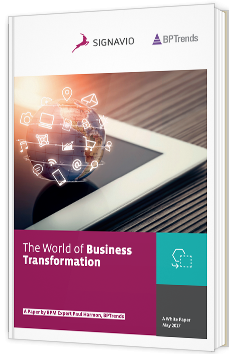


"Transformation est le nom actuel des efforts d'amélioration des processus métier. Ce terme étant devenu populaire, les auteurs ont décrit de nombreux types d'efforts de transformation. Récemment, l'accent a été mis sur les transformations facilitées par les technologies de l'information. Toute une série de changements dans la société et de technologies que les organisations doivent adopter si elles veulent prospérer au cours des prochaines décennies, notamment les attentes des clients et les informations pouvant être obtenues en appliquant des analyses à de grands magasins de données. fait référence à l'utilisation des technologies d'intelligence artificielle (IA) pour rendre les applications plus flexibles. En particulier, une transformation cognitive améliorera les processus d'une organisation en ajoutant des interfaces en langage naturel, des capacités sophistiquées d'aide à la décision et en utilisant des dispositifs robotiques intégrant intelligence et langage naturel. interfaces. Ces t Les deux types de transformation représentent des exemples d’une suite de changements informatiques auxquels les organisations sont confrontées. Nous examinerons diverses applications des technologies numériques et cognitives et la manière dont elles modifient les processus. Nous examinerons en particulier les opportunités dans le secteur des assurances. Nous examinerons également brièvement ce que les organisations devront faire pour tirer parti des possibilités offertes par les transformations numériques et cognitives.
Amélioration de processus sous un autre nom
L'amélioration des processus est une préoccupation constante de toutes les entreprises. Tant que des groupes de personnes ont travaillé ensemble pour créer et vendre des produits, certains d’entre eux ont essayé de déterminer comment créer ces produits plus rapidement, mieux et à moindre coût. Les archéologues peuvent dater le développement des civilisations anciennes en suivant l'évolution de la manière dont les bols et les pots ont été cuits et décorés. Ainsi, même sur les rives du Nil, les anciens potiers cherchaient apparemment à améliorer leurs processus en créant des produits moins coûteux à fabriquer, meilleurs ou plus agréables pour leurs clients. "
Version originale :
"Transformation is the current name being given to business process improvement efforts. As the term has become popular, authors have described many different kinds of transformation efforts. Recently, there has been a considerable emphasis placed on IT-facilitated transformations. Digital transformation refers to a whole collection of changes in society and technologies that organizations must adopt if they want to prosper in coming decades. Key among the changes requiring a response are those in customer expectations and information that can be gained by applying analytics to large data stores. Cognitive transformation refers to the use of Artificial Intelligence (AI) technologies to make applications more flexible. Specifically, a cognitive transformation will improve an organization’s processes by adding natural language interfaces, sophisticated decision support capabilities, and by using robotic devices that incorporate both intelligence and natural language interfaces. These two types of transformation represent examples of an ongoing sequence of IT change that organizations face. We’ll consider various applications of digital and cognitive technologies and how they change processes. We’ll look, in particular, at opportunities in the Insurance Industry. We’ll also consider, briefly, what organizations will need to do to respond to the opportunities that digital and cognitive transformation raise.
Process Improvement by Another Name
Improving processes is a continuing concern of every business. As long as groups of people have worked together to create and sell products, some among them have tried to determine how to create those products faster, better, and cheaper. Archeologists can date the development of early civilizations by tracking changes in how bowls and pots were fired and decorated. Thus, even on the banks of the Nile, ancient potters apparently strove to improve their processes by creating products that were cheaper to manufacture, better, or more pleasing to their customers."